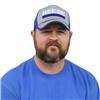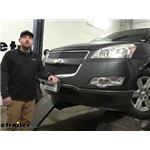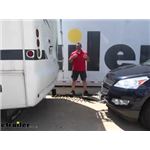Blue Ox Base Plate Kit - Removable Arms

Will this fit?
To see if this custom-fit item will work for you please tell us what vehicle you'll use it with.
- All Info
- Reviews (3075)
- Q & A (0)
- Videos (2)
- Photos
Blue Ox Tow Bar Base Plate - BX1683
- Blue Ox
- Removable Draw Bars
- Twist Lock Attachment
Custom designed to fit your vehicle so it can be safely towed behind your RV, this base plate has easily removable arms that offer a seamless look when you're not flat towing. Base plate bolts directly to your chassis, so no welding is required.
Features:
- Custom-fit base plate provides attachment points for your tow bar when flat towing
- Hidden design provides a clean, seamless look
- Arms remove with a simple twist when not in use
- Brackets won't protrude past the front of your vehicle
- Sturdy design spreads towing force evenly to prevent stress on your vehicle's suspension
- Integrated mounting points let you easily attach an electrical connector plug with bracket (sold separately)
- Receiver covers keep dirt and debris out of the base plate when arms are removed and provide a finished look
- Durable steel construction is powder coated to resist rust and corrosion
- Straightforward installation - no welding required
- Base plate bolts securely to your vehicle's chassis with included mounting hardware
- Sturdy lugs pair with Blue Ox tow bars to form a secure and reliable connection
- Adaptable for use with Roadmaster tow bars - adapter (RM-031 or RM-031-5) sold separately
- Adaptable for use with Demco tow bars - adapter (BX88310) sold separately
- Made in the USA
Specs:
- Distance between brackets: 20"
- Bracket height: 16"
- 3-Year warranty
Simple, Hidden Design


This base plate's hidden design creates a clean and seamless look. The bracket arms are easily removable, creating a slick appearance when you're not flat towing. Because the arms can be removed, you also won't have to worry about banging your leg into any protruding arms when you walk by.

Attaching and removing the bracket arms is a breeze. To attach the arms to the base plate, simply insert them into the receivers and rotate them until they lock into place. Once you're finished towing and want to remove the arms, pull the pin to disengage the lock, rotate the arms, and remove them from the receivers. Finally, plug up the now empty receivers with the included receiver covers to help keep dirt and debris out of the base plate and provide a finished look.
Guide to Flat Towing
Flat towing your vehicle is much more convenient than using a trailer or a tow dolly. These other options take up much more storage space, leaving you less room both at home and at the campsite. In addition, securing your vehicle to a trailer or tow dolly can be a hassle and more time consuming than hooking up with a tow bar.
There are 5 basic components needed when flat towing a vehicle: a tow bar, a base plate kit, a safety cable set, tow bar wiring, and a supplemental braking system.

The tow bar links your towed car to your motorhome. It attaches to the custom-fit base plates that install on the frame of your towed car. Safety cables ensure that your towed car does not separate from your motorhome in the event that your tow bar becomes detached. Tow bar wiring allows your towed vehicle's signal lights to sync up with your motorhome's tail lights, which is required by law in most states. Finally, the supplemental braking system - also required in most states - brakes your towed car when the brakes in your motorhome are activated, preventing wear on the motorhome and decreasing braking distance for your entire setup.
BX1683 Blue Ox Baseplate - Removable Tabs
Installation DetailsThis Product Fits The Following Vehicles
- 2009 - 2012 Chevrolet Traverse


Videos are provided as a guide only. Refer to manufacturer installation instructions and specs for complete information.
Video Transcript for Blue Ox Base Plate Kit Installation - 2011 Chevrolet Traverse
Hey everybody, my name's Ryan and here at etrailer we install, test, fit and review a lot of different parts. That way we could try to answer any questions those of you might have. And that's exactly what we're doing here today. On our 2011 Chevrolet Traverse. We're gonna be taking a look at and showing you how to install the blue ox base plate kit with removable arms. So you're gonna have a total of five main components needed to flat tow your SUV down the road safely.
First, one's gonna be the base plate. Base plate is gonna provide us with a solid and reliable connection point. That way we can hook our tow bar up to it. And that tow bar is gonna connect to the base plate here at the front of your vehicle to the back of your motor home. And that's gonna be that physical link that actually pulls your car down the road.
The third main component is gonna be safety cables and those are there in the event of an unlikely disconnect. Those are gonna keep the SUV connected to your motor home. The fourth main component is going to be tow bar wiring. And so that wiring is gonna plug in to the front here and to the back of your motor home. And that's gonna transfer the lighting signals to the back of your traverse, that way other motorists know your intentions as you're going down the road and last but not least the fifth main component is going to be a braking system.
And what that braking system is going to do is apply the brakes and your Chevy. Whenever you hit the brakes in your motor home that's just gonna help bring you to a more safe and predictable stop. And these aren't necessarily needed, but there are two more products that I would recommend picking up, just to make your overall experience a little bit easier on you. And that is the Road master fuse bypass as well as the fuse master. And I say that because Chevrolet does recommend that we take two fuses out every time you want a flat tow and that can just kind of get tiring having to pop the hood, pull the fuses out remember to put them back in every single time you want to flat tow.
So with these two products are gonna do is eliminate that. So as opposed to manually pulling them fuses out all you'd simply have to do is flip the switch into the tow position, and you're ready to hit the road. Whenever you are flat towing, you're gonna want your base plate to give us that solid connection point and all of the base plates that we offer are going do that. But honestly, if it we're me, I would want a base plate that would look pretty good too whenever you're not using that. And honestly, I think this one does a great job of it. It blends in pretty well. We don't really have to modify our front bumper a whole lot and make a bunch of cuts and hack everything up. And with that being said this one's gonna give us a nice clean factory appearance. But even though our base plate does give us a nice clean look. It doesn't mean that we're gonna have to sacrifice the usability. It's still gonna be very easy to operate and figure out and everything else. One talks that I do like is the fact that they give us some of these little caps whenever we're not using it can pop those in. Not only does it look cleaner but it does help keep any contaminants out. That way everything will operate smoothly. And since we have removable arms whenever we are ready to hook up all we're gonna have to do is grab our arms, rotate them about a quarter turn until they lock into place. You can do that for the other side as well. Once we have those in there we're ready to hook up to our tow bar. One thing I do like is the safety chain openings here. These things are nice and thick, and I feel like if something we're to happen, I could really rely on these. And what's nice too. They come out just enough to keep everything looking clean and easy to use. So the majority of the safety chain hooks at least the ones that I've seen have been styles like this. And regardless of which one you have they're both gonna fit on there with no problem. This base plate is going work with the majority of blue ox tow bars. And even if you don't have a blue ox tow bar chances are pretty good. You can make it work. And that's because there's adapters available that you can put on your tow bar to connect to this base plate. So if that's your situation, you can always check right here at each trailer and find those adapters. There is one thing I do want to mention and that is the use of a high, low adapter. And I say that because say our vehicles gonna be riding at a certain height. Our base plate is, and chances are pretty good our motor home is going sit higher or lower than our base plate. And what we want is for our tow bar whenever we have everything hooked up we want that tow bar to be riding nice and level. So you want the hedge pen on your motor home side to be within three inches of the pen hole here in the base plate. So what you would do is parked on level ground, measure from the center of your base plate, hold air down to the ground record that measurement, do the same thing on your motor home measure from the pin hole to the ground. And as long as they're within three inches you're in good shape. You're not gonna need a high-low adapter. But if it exceeds that measurement I would definitely recommend picking up a high-low adapter to keep everything nice and level. And you can find a bunch of different sizes and types of high lows right here at etrailer. So at the end of the day, really clean, simple and easy to use base plate that you really can't go wrong with. Now, as far as the installation goes, I'm not gonna lie. It is a little difficult. You do have to remove the front facia and do some drilling to get the base plate in. But honestly, that's pretty common with a lot of base plates. So as long as you take your time and stay focused you should be able to do it at home. Speaking of which let's go ahead and put it on together now. To begin our installation, we're gonna be here at the front of our traverse, pop the hood. And what we're gonna need to do is remove this plastic cover that runs along the length of our engine bay here. And this is gonna be held in place by multiple pushpin style fasteners. So all the fasteners are gonna look like this and the way to get them out is you're gonna pry underneath the head of the fastener. I'm using a trim tool. Makes it easy but you can also use a Flathead screwdriver. We're just gonna pull the whole thing out like so. I'll do that same thing to get all of the fasteners removed. Once you have all the push pins removed, you could come here to the corner. You can see the seal is connected. You can just kind of grab it and pop it up and do the same thing on the other side. And once we have those removed should be able to grab our cover and set it to the side. Now we can do, we're gonna have three fasteners along this front edge, and we need to remove those in our case, they're just Phillips head screws. So we get those pulled out and do the same thing on the other side of our vehicle. And I want to mention from this point on anything we do to this side we're also gonna do to the other side 'cause it will be set up the same way. Now, if we come here to our wheel well along this front edge, we're gonna have two T15 fasteners that we need to pull out. And when you're doing that, it does help to turn your tire in a little bit. There's a little more room to work. So now that we have those out, we're gonna have one more fastener to be right there in the corner. And we're gonna use a 7mm socket to get that one removed. Now, underneath the vehicle, along the front edge we're gonna have a few fasteners we need to pull out. We're gonna have two T15 Torx bits. Get them out. And then you're gonna have a 10mm right here that you can pull out as well. If you look, our a plastic piece is actually broken there. So I'm not gonna worry about pulling that out. If you're as, as connected though you definitely want to get bolt removed. Now with an extra set of hands we can actually get our facia removed. So what I did is just put some painter's tape along the seam here. That way we don't have to worry about accidentally scratching up her pain or anything. And what you're gonna do is starting from the corner here. You can kind of just pull out on it and it will release these clips. We can work our way around. We may or may not have some electrical connectors. So don't pull this off completely just yet in our case looks like we are gonna have a connector. Kinda work this off, flip it around to disconnect it. You're just going to push down on the center tab, pull it apart. And there's gonna be the same one on the other side. Well, with this removed we can set it off to the side somewhere safe. So now if you look right here we're gonna have these flaps and we need to trim some of it up, to make room for the base plate. It's kind of a soft rubber. I'm just gonna grab a pair of scissors and cut that piece out. We need to get this removed and out of the way. So I'll just go ahead and pull out this push pin fastener and set it to the side. Now we need to do is trim out a portion right underneath our bumper here and this little plastic support. There's a diagram instructions that give you some measurements. And so I went ahead and drew those out. And when you're cutting this you want to make sure not to cut into the flange behind here. So you wanna level with the frame rail that's behind this and when you're cutting this you also want to cut just inside here. So you wanna make sure to leave this center rib in place. So we're gonna be cut on this side of it. And about here. I'm gonna use a couple of different tools to do this. I'm gonna use a Dremel tool to cut out this portion and a little ways down here. And then I'm gonna come back in with a saw to get a straight shot down here and get all this material removed. So can use a few different tools whatever kinda suits your needs, the best to get this done. Now just over here on the driver's side we need to remove this temperature sensor for the time being, let's use a trim tool to at least that fastener should just kind of pop out. And then what we'll do is just kind of lean it over the top of our bumper out of the way. On each side of her vehicle, we need to remove our horn. And this is pretty simple. We're just gonna have one 10mm bolt up here Pull that out. And what I'm gonna do is just disconnect it, that way it's out of the way. To do that there's a tab there in the center of the connector. You push it down on pull the two apart and I'll just set her horns off to the side. At this point, we can go ahead and remove our washer fluid reservoir. So we first want to start by disconnecting the electrical. I'm just gonna have a few of them. They're harder to work the same and just pull back on the tab and separate it. Just kind of push your wiring out of the way. And then we can disconnect the lines. I already pulled one off and what some of the fluid drain out, we just drained it into a bucket. Thankfully they Rosen a whole lot in there but these are pretty straightforward though. You just pull it off and your fluid will drain out of those there. And then to actually remove our tank, we're gonna need to remove these three 10mm nuts. Should be able to grab the tank. Kind of work it down. Now when I went ahead and did, is this drew out a couple of reference lines here on the side of our frame rail. That way it'll help us line up the base plate make sure it's gonna rest where we need it to. There are measurements in your instructions. And I will say one thing I did notice if we go the six and a quarter inches this way from the front of our frame, rail back it's going to not only interfere with this stud but also it's gonna interfere with some of our plumbing lines on the front of vehicle the base plates going view, make contact with them. So what I've done as a, shorten it up about a quarter inch that way it'll push a base plate a little more forward and we'll get that clearance that we need. Now we can grab our base plate and it's gonna slide in between them openings that we cut. We can make sure we get it in place. Once you have it roughly in place I'm gonna take a clamp, and just clamp the base plate. That way it'll kind of hold in position and we can get it exactly where we need it to be. Now, we know we have the base plate level and where it should be. We can drill out a hole and I'm gonna be drilling out this one here through the pinch weld to the size listed in our instructions. With that hole drilled out. We can take a one inch bolt and we're gonna apply some red lock tight. Matter of fact all of the hardware that we're gonna use to secure the base plate. We'll get some of this red lock tight. You can grab this right here to your trailer. We're gonna push this through. And then on the other side back here where the bolt comes through I'm going loosely secure a split lock washer and a hex nut. So when I went ahead and did, as I simply tighten this bolt down on each side of her vehicle, so I use a nine 16 socket and wrench to hold the nut from spinning. And once that's tight it's gonna hold our base plate and position. That way we can get rid of the clamp. And then what we're gonna do is take that same drill bit and drill out these three remaining holes using our base plate as a template. Once you have those drilled out and get the rest of our hardware in for this opening down here we're gonna use the same setup as this one just be one inch bolt, Robach tight. We're gonna push that through on the other side secure a split lock washer and a hex nut. For these two we're gonna do something a little bit different and we're gonna use what's called a handle nut. So the way these are gonna work is there's an opening in the bottom of our frame rail here. We're gonna feed that through and that is gonna line up with our holes there. You may have to kind of bend the handle nut accordingly to get it to line up correctly on the inside. And when you do that, be very careful. You don't want to grab this end and bend it directly there because I've, I have had these break off. So just something to keep in mind. And matter of fact, what I did is just put some sealer or some JB Weld around there too just as a little bit of extra backup that way we don't have to worry about them breaking. You don't have to but it is a little precaution you can take. And when I suggest doing, so this is the bolt that's gonna go through these two holes. It's a little bit longer one. So you're gonna put a split water washer on it. Don't forger your real lock tight you're gonna feed through there. But before you do that what I do suggest doing is taking your handle nuts and just running these in by hand, make sure they go in nice and smooth because sometimes the paint can kind of hang it up a little bit and make it a little tricky to get started. So on the bottom of the frame rail, you could see this is the opening that we're gonna use to put our handle nut in and get it lined up. So now we have all of our hardware in place. We need to come back and snug it all down And then we need to come back with a torque wrench and tighten down all of the hardware to the amount specified in the instructions. After everything's twerked. And I'm gonna do is come in with a pair of snips and just trim off that remaining handle nut. That way kind of cleans up our install look and prevents these from rattling around and making a bunch of noise. Now we can go ahead and do is re-install our windshield washer reservoir. Now the three studs on the frame here that was holding the reservoir on kit's gonna come with a bunch of flat washers, just like this. You're gonna take six of them and place them over each stud. What that's gonna do is kind of pull that tank out and that way it'll clear our base plate. So got them on all three. We will work this back into position and just re-secure it, using the factory nuts. Now we can go ahead. Tighten everything down. We'll just plug all of her lines back in and our electrical connectors. Once we have that done, go ahead and grab our horn. And re-install that just see opposite way. Have you removed it Now we can go ahead and re secure our temperature sensor. Now what you're gonna do is just remove it from this bracket that it originally came on kind of just pinch those in it pops out and on this plastic piece here on the driver side I just drilled a half inch hole and this is simply just gonna push right into place. So now what we can do on each side is install our safety cables. Now these are pretty straightforward. I wrapped it around this portion of the frame and this part here, it goes around the plastic. I simply just wrapped it around that to kind of take up some of the slack. And these are gonna get connected to the base plate using this quick link. So that runs through the base plate and the cables go through it. And then what you want to do is make sure the safety cables nice and tight. That way it's not moving around touching other engine components or anything like that. So I removed all the slack and secured it using a handful of zip ties. And I did it the same on each side of the vehicle. Now, at this point it would be a great opportunity to install some of your other flat tow components like a braking system or diode wiring. And I say that because we're gonna have all this extra room to work with our facia still removed. So that's exactly what I'm gonna do. And if you have those components I recommend you do that as well. So now at this point what we can do is re-install our facia. Now that we have our other components on. What I went ahead and did, was this kind of held our facia up to the front of our vehicle as best as I could, and looked to see where our base plate interferes with our grill. And it looks like there's really not a whole lot we're gonna have to remove. I put a couple of marks here and I think that's the only area that we should need to trim out to let our base plate pass through. I'm gonna get these cut out, test fitted, it again and if you have to come back and cut out a little more no big deal. This is relatively thin plastic. I'm just gonna use a tool like this. You could also use regular snips, probably a thermal tool utility knife, whatever you have laying around. I wanna head and put our facia back into position. And I want to mention I did have to cut out another wrong right there. So I actually did that with the facia on the cart, just quite didn't want to sit perfectly flat. So I cut that out. And then I also just had to cut out a small opening there. That way our wiring connector was more accessible. But now that we have this on the front of our vehicle we can go ahead and read, secure it the opposite way that we removed it. And that'll finish up our look out and our installation of the blue ox base plate kit with removable arms on our 2011 Chevy Traverse..
Customer Reviews
Blue Ox Base Plate Kit - Removable Arms - BX1683
Average Customer Rating: 4.8 out of 5 stars (3075 Customer Reviews)
Custom designed to fit your vehicle so it can be safely towed behind your RV, this base plate has easily removable arms that offer a seamless look when you're not flat towing. Base plate bolts directly to your chassis, so no welding is required.
Absolutely love our Blue Ox system. Was easy to install (with a little mechanical help) and has served us over 11,000 this past year. We were extremely fortunate that etrailer had a video of our exact year and model which made installation even easier.
We've towed over all sorts of terrain and would absolutely purchase this again and recommend it to anyone who asks!

I’ve enjoyed my purchase!

My backyard mechanic had a relative easy time installing the BX1683 tow frame on my 2009 Traverse . Hookup to the tow bar is easy.

The size of the box terrified me but I had to do this one myself.
This project is not for the faint of heart. When you think about what could go wrong you could wet yourself. I went with my gut and just opened the box. Hmmm, packaged very well with everything you need for the install. No going to the hardware store for this or that. Sat there with a cold sarsaparilla and read the very detailed instructions, went back to the etrailer web site and checked out some vids and pics. Hmm, it didn’t seem that daunting of a job. On my 04 Lexus GX470 most of the holes were drilled. Before I knew it 5 hours had past and I owned a toad! I took it to my local Rv service center for an inspection and it was deemed safe to use.
This thing is awesome, tracs straight as an arrow.
Now, I have to figure out this diode lighting kit. Camping is fun! Yah!!! :) Noah and etrailer made this a tolerable project. I urge everyone to take advantage of the resources that are on this sight. I always learn something when I’m there. See y’all on the trail….Rod
Well, I'm glad I'm good with tools, grinders, drills, and such. It was not just bolt-on dal. The car grill was able to be used any longer as it was too tight of a fit. Some of the lower fascia had to be trimmed and also removed OEM nuts from the front, the angle wouldn't allow the stock nuts to work. But in the end, I got to work out. So prepare to spend around 4-6 hours playing with it to get it to work. I am positive it's going to work as intended.
everything bolted up easy, i simply drilled hole’s into were needed and supplied my own bolts straight through for easy installation.
I am really happy, not only with the product but the customer care I received. Very quick and helpful!!
I would make one suggestion. Take the headlights out when doing this on a Chevy Cobalt. It will make it much easier to get to the 3 bolt holding the fender to the fascia.

This kit fit well, had decent instructions, and performed perfectly every time once installed. If doing the install yourself, you'll need some metal fabrication tools to notch the D-ring plates behind the bumper but it's not complicated, just a little time consuming depending on the tools you're using. The look is also a little weird on the front of a new Bronco since you're losing the burly bumper D-rings, but it's a well engineered setup overall. I only used the tow bar setup a couple times before the vehicle was lost in a wildfire so I can't comment on the longevity, but I have no doubt it would still be working fine today.

I will start with the people that work here at etrailer are great to deal with and very helpful! These baseplates for my 2023 bronco have been great. i bought and installed myself. install pretty straight forward. and these work great for flat towing my bronco behind my motorhome.

Excellent Product. Heavy Duty. You can install it if you have basic skills. After complete, we took our 2017 Subaru CrossTrek on a 6000 mile cross country tow. Worked great!
Installed successfully on my 2024 Trax LT. However, with respect to the following installation steps, I made some changes:
All - Don't use a reciprocating saw! An oscillating tool and saw attachment works best, allowing more precise cuts.
Step #8 - After consultation with BlueOx Tech Support, I elected to re-install the plastic shroud. Wasn't difficult and I felt better about maintaining the integrity of the original equipment.
Step #28 - I moved the temperature sensor to a forward facing position in the grill section directly above the baseplate.

eTrailer was very helpful in choosing the correct hitch for our rv and car. They also provided a special brake application in the car that makes it super easy for toad braking.
I am 72, and I hook up this toad and pull it with confidence. The instructions to hook up the toad was presented with ease. They knew exactly what they were doing, and we didn't rush through the demonstration. I would recommend eTrailer to anyone.
It took all afternoon to install it by myself, but the online video was perfect and the product fit without an issue. Our second vehicle to use their tow plate and we have been very happy each time!Great product and dealer.
Baseplate installation went pretty smooth with no surprises. I chose to separate the lower grill piece while I had the bumper cover off. This allowed me to install the bumper cover over the baseplate and then accurately determine where to make my cuts in the grill for the baseplate protrusions. The Blue Ox base plate is well made and fit perfectly.
Etrailer offered competitive pricing for the base plate and the package was shipped promptly and arrived very quickly...much faster than I had anticipated.
The packaging was excellent and included all documentation. Installation was very straightforward and the unit was a perfect fit with minimal modifications to the car itself. Only a few small pieces of plastic had to be trimmed for a perfect fit.
We did have some trouble with 2 of the nuts-with-wires attached in that the bolts did NOT want to thread in to them. For some reason, they just did not want to 'start' easily and this made the blind installation of the nuts on the bolts extremely time-consuming. The nuts/bolts did not cross-thread and there were no other issues once we were able to use a tool to jam the blind nut and stop it from moving so that the bolt could be tightened and torqued. 4 of the 6 went in smoothly and with zero issues, so do I not believe that it was 'installer error' (!).
In the end, a perfect installation and the base plate is nearly invisible. I would definitely purchase from eTrailer again and can easily recommend their products based on this experience.
Pretty easy to do my self but the instructions could have been a bit larger with more pictures. I think the hardest part was drilling the holes to attach the two brackets as there was only one hole on each frame. Getting the square nuts with wire attached were difficult to get both aligned because the wire on the first one got in the way each time
My only negative comment is that this base plate sets the tow bar connections 23" above the ground making it somewhat of a pain to fine towbar and hitch connections. It mounts relatively easy.
The hitch is a great product; however, the installation is not a bolt on and you are done process as I was led to believe. It is highly doable with a little fudging, die grinding to fit, and tweaking. The grainy instruction pictures leave a lot to be desired. It looks good on my 2014 Suzuki SX4 and I am glad to have it, but even as an experienced body shop man it is still a challenge to install. Would I do it again, yes, without hesitation. It is solid, durable, and looks good in my grill.
Everything as advertised. Followed the videos and instructions for installing the base plates and tow bar and all were good. Did a test pull today and it towed great, straight as a dye. I only have 2 suggestions. There was no mention in the video of the space plate, which was included. Figured it out. Second suggestion, Install a 2" ball on your work bench and adjust the receiver to it. The instructions tell you what socket to adjust it with but that could have been done on the bench before shipping. Great product, so excited. We are off on a few hundred mile trip with the Fit behind the motorhome Wednesday. So excited. No more tow dolly.

I had the base plate installed by the Chevy dealer we purchased the car from. They had to make a modification to the car, but all seams to be well and have towed it several thousand miles since.
One thing, PLEASE, OH PLEASE remove my name from your email list. Not a day goes by without an email from e-trailer that I could care less about. I have tried unsubscribeing to no avail. Your service is great and your people are very knowledgeable, thank you for great service.

This kit was installed on my 2018 Toyota Tacoma TRD Sport 4x4 last summer. The directions aren't too bad if you have mechanical aptitude. It seemed that there could have been an easier mounting method. The nuts with wires welded on so you can snake them into place inside the box frame were definitely a pain in the a$$. You will need to have plenty of patience. A vehicle lift would also be an asset. It worked as well as any other Blue Ox baseplate we have had for other vehicles so no issues there.
It turned out fine but my opinion is that you should have some average or above mechanical skills to install this yourself. As you can see, the base plate protrusions are hardly noticeable at a distance with the tow pins removed. One thing worth mentioning is I had to mount it more rearward on the frame because the front valance would not mount back on correctly. Overall, good base plate.

Bought it at etrailer as I have with other trailer hitch related parts. Installed it myself, and it was a real job. I figure about 10 hours to get it right so I didn't have to worry if my 'toad' would pass my motorhome as I tooled down the road. Fit was perfect for my 2008 Honda CRV, but make sure you keep that oil cooler line up as high as possible or you will be redoing the fit to get the front cowling back on the car. Bought an angle grinder with cutoff wheels and that made the frame notching a lot easier. Note that if the removeable attachment pins are a tight fit into the base plate, they will loosen up with a good silicone lubricant and the wear of towing. I have towed with confidence for a year without a hitch (pun intended).
The item I received must have been a returned item. The box label was proof it was shipped to someone else before. Reason I'm not happy is because the bag of screws was open and most of it slipped out of the holes of the damaged box that was opened before and re-taped. The end of the crossbar was bent and not much packing inside. I needed this for our trip, so I didn't return it and had to fix and find screws to make it all work.

This baseplate fit perfectly and was a pretty easy instal after removing the bumper wrap on my wrx. Car pulls steady and straight!!
See what our Experts say about this Blue Ox Tow Bar Base Plate
- Replacement Arm for Blue Ox Base Plate BX1683For your Blue Ox Baseplates # BX1683, the replacement Blue Ox Attachment Tab Assembly is part # BX62-3469. This part number is for one removable attachment tab assembly. Since the attachment tab is bent, we strongly recommend that you have the tow bar and base plates checked out by a qualified mechanic to make sure that nothing else is damaged and the system is safe to use.
view full answer...
Info for this part was:










At etrailer.com we provide the best information available about the products we sell. We take the quality of our information seriously so that you can get the right part the first time. Let us know if anything is missing or if you have any questions.

































































































































Thank you! Your comment has been submitted successfully. You should be able to view your question/comment here within a few days.
Error submitting comment. Please try again momentarily.